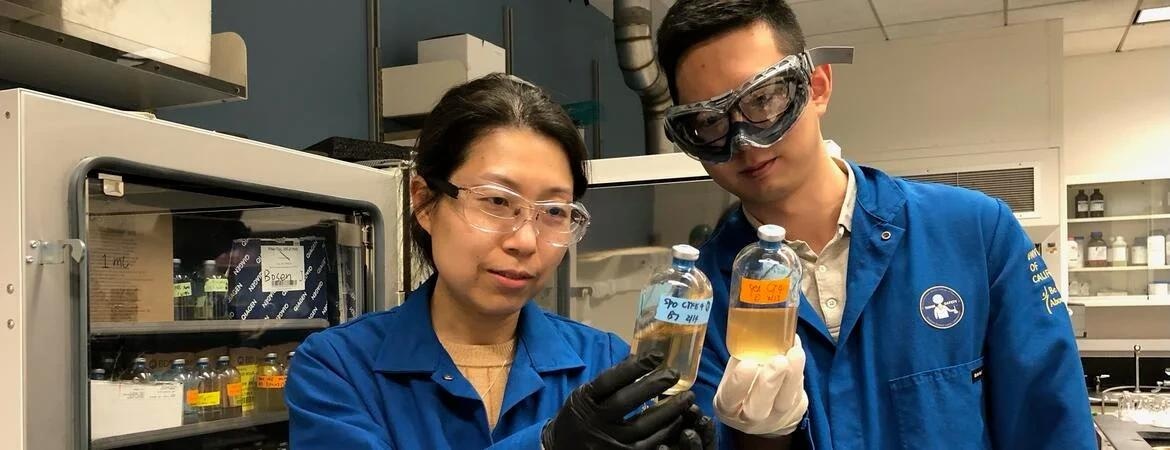Reviewed by Danielle Ellis, B.Sc.May 31 2023
Chemical and environmental engineering researchers from the University of California, Riverside, have determined two species of bacteria discovered in soil, which collapse a class of stubborn “forever chemicals.” This gives belief in affordable biological clean-up of industrial pollutants.
 Assistant Professor Yujie Men and graduate student Josen Jin. Image Credit: UCR/Sizhuo Zhang.
Assistant Professor Yujie Men and graduate student Josen Jin. Image Credit: UCR/Sizhuo Zhang.
Such bacteria cause harm to a subgroup of per- and poly-fluoroalkyl substances, otherwise called PFAS, which consists of one or more chlorine atoms within their chemical structure, Yujie Men, an assistant professor in the Bourns College of Engineering, and her UCR collaborators, reported in the journal Natural Water.
Unhealthful forever chemicals remain in the environment for several years or much longer due to their exceptionally strong carbon-to-fluorine bonds. Notably, the University of California-Riverside (UCR) team discovered that the bacteria cleave the chlorine-carbon bonds of the pollutant, which commences a chain of reactions that ruin the forever chemical structures, thereby rendering them safe.
What we discovered is that bacteria can do carbon-chlorine bond cleavage first, generating unstable intermediates. And then those unstable intermediates undergo spontaneous defluorination, which is the cleavage of the carbon-fluorine bond.”
Yujie Men, Assistant Professor, Bourns College of Engineering, University of California-Riverside
In the forever chemical family of thousands of compounds, chlorinated PFAS are known to be a large group. They include a range of non-flammable hydraulic fluids that have been utilized in industry and compounds utilized to make chemically stable films that act as moisture barriers in several packaging, industrial, and electronic applications.
The two bacteria species named—Desulfovibrio aminophilus and Sporomusa sphaeroides—identified by Men’s group are naturally occurring and are considered to live in the subterranean microbiomes where groundwater might be contaminated with PFAS.
For accelerated cleanups, an inexpensive nutrient, like methanol, can be injected into groundwater to encourage bacterial growth. This would highly increase the bacteria’s existence to ruin the pollutants very effectively, stated Men. If the bacteria are not present already, the contaminated water can be inoculated with one of the bacterium species.

Image Credit: Kateryna Kon/Shutterstock.com
Men is the corresponding author and Bosen Jin, a UCR chemical and environmental engineering graduate student, is the lead author. The other UCR co-authors are postdoc Jinyu Gao; postdoc Huaqing Liu; former graduate students Shun Che and Yaochun Yu; and Associate Professor Jinyong Liu.
The preprint version of this study by Bosen Jin won several awards, such as the ACSenvr’s C. Ellen Gonter Award for graduate students in environmental chemistry, the ACSenvr- Society of Environmental Toxicology and Chemistry Exchange Award, and the 2022 Battelle 12th Chlorinated Conference Student Best Paper Award.
The study extends on earlier work by Men, in which she illustrated that microbes could break down a stubborn class of PFAS known as fluorinated carboxylic acids.
For a long time, microbes have been utilized for the biological cleanup of oil spills and other industrial pollutants, such as the industrial solvent trichloroethylene or TCE, which has been studied by Men.
However, what is known regarding using microorganisms to clean up PFAS is still in its starting stage, stated Men. Her breakthrough displays great promise as biological treatments, if efficient pollutant-eating microbes are available, are generally affordable and more eco-friendly compared to chemical treatments. Also, pollutant-eating microbes could be injected into hard-to-reach locations underground.
The latest PFAS study performed by Men comes as the US Environmental Protection Agency is promulgating new regulations to impel cleanups of PFAS-contaminated groundwater sites across the nation since such chemicals have been associated with a host of ill health effects, such as kidney disease, cancer, and hormone disruptions.
Beginning in the 1940s, PFAS compounds came into extensive use in thousands of consumer products—such as grease-resistant paper wrappers and containers, and fire suppressants—due to their potential to develop safe coatings that resist heat, lipids, and water.
According to Men, determining the bacteria species that ruin some forever chemicals was a great step ahead.
Now, we know who they are. So, we can use the pure cultures to further understand the degradation mechanisms, which enzymes are involved, and whether we can manipulate or modify those to make them better.”
Yujie Men, Assistant Professor, Bourns College of Engineering, University of California-Riverside
Source:
Journal reference:
Jin. B., et al. (2023) Substantial defluorination of polychlorofluorocarboxylic acids triggered by anaerobic microbial hydrolytic dechlorination. Nature Water. doi.org/10.1038/s44221-023-00077-6.